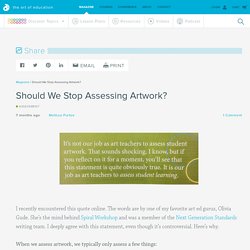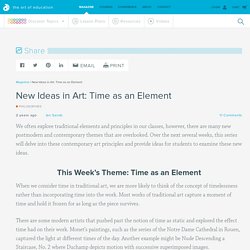

Let's Face It: Your Students Aren't Going to Be Artists - The Art of Ed. When I was in 7th grade, a sketchbook assignment invited me to “draw what you want to be when you grow up.”

I aspired to be a dentist and vividly drew a dental scene. I’m sure my art teacher never thought I’d turn out to be an art teacher, but somehow I did. This can be said for most of our students. Do we really expect them to grow up to become artists? I can honestly say, “No.” 1. We use design thinking strategies constantly in the art room. 2. Many art rooms could be mistaken for hardware stores due to the number of tools found within. While some trade skills will be used more than others, they are still beneficial to learn.
Should We Stop Assessing Artwork? - The Art of Ed. I recently encountered this quote online.

The words are by one of my favorite art ed gurus, Olivia Gude. She’s the mind behind Spiral Workshop and was a member of the Next Generation Standards writing team. I deeply agree with this statement, even though it’s controversial. Here’s why. When we assess artwork, we typically only assess a few things: How the student followed directionsHow the student applied media or process Neither one of these is hugely important. Following directions is about behavior, not what students know or can demonstrate. As for applying media and process, sure, art teachers need to think about how students have progressed with art-making skills. We should stop assessing student artwork because it is such a limited measure of learning. If we truly want our students to develop as artists, we need to look at what an artist does holistically, which is what the National Standards ask us to do. So, should we stop assessing artwork? {image source} I Don't Like Grading, And, Uh, I Don't Think I'm Gonna Grade Anymore - The Art of Ed.
There is a scene in the movie Office Space where the main character, Peter Gibbons (Ron Livingston) is on a first date with Joanna (Jennifer Aniston).

Peter is accidentally stuck in a hypnotic state of relaxation. This is the dialog that follows when Joanna asks Peter about his job. Peter Gibbons: I uh, I don’t like my job, and, uh, I don’t think I’m gonna go anymore. Joanna: You’re just not gonna go? Peter Gibbons: Yeah. Should We Stop Assessing Artwork? - The Art of Ed. 20 Quick Formative Assessments You Can Use TODAY - The Art of Ed. Magazine / 20 Quick Formative Assessments You Can Use TODAY We are always looking for a better glimpse inside our students brains.

While we are never going to figure out the mysteries of the pre-teen or kindergarten mind, there are some tools to help us understand where they are in their learning journey. Below are 20 simple, quick, effective ways to check on your students and get some real information to plan instruction. As a bonus, kids get in on their own learning and goal setting! Outcome Sentences – Use when you want to prompt a student to respond in a specific way (I learned…, I wondered…, etc.).Conga Line – a great way to share ideas with different partners; two lines of students face each other, one line moves with same question or a new one.Inner/Outer Circle – same as Conga Line except with circles, better for limited spacesHeadlines – after a lesson or lesson segment, have the student write a headline for an article about it.
7 Paint Routines You’ll Never Regret Teaching - The Art of Ed. Let me start by saying that I know routines are extremely important, especially in the art room.

However, it wasn’t until this year that I made an effort to really teach the routines below with my students. I honestly thought that it was easier if I did the distribution, maintenance, and clean-up on my own. Boy, was I wrong! First, my students rock these routines. They love the added responsibility, and I’m sure they love less nagging from me. 1. Develop a system that will allow students to get their own paint. 2. How to Turn Your Students Into Neat Freaks - The Art of Ed. When I was a kid, my sister used to vacuum her room in such a way that she would know if I had been in there simply by looking at the carpet.

In her eyes, I was a complete mess while she was the family’s steadfast “neat freak.” Once college rolled around, I quickly learned that I either needed to start being organized or risk misplacing much of my stuff. Thus, my days of cleanliness and order began. Unfortunately, those two characteristics are not always synonymous with my day job. Artist-Statement-Flow-Chart-final1. Scaffolding-Ceramics. An Engaging Critique That Taps Into Your Students' Love of Quick Communication - The Art of Ed.
Magazine / An Engaging Critique That Taps Into Your Students’ Love of Quick Communication 21st-century students tend to be excellent communicators.

Wait…let me rephrase that. 21st-century students tend to be excellent communicators when the communication is taking place through the aid of technology. Texting, Instagramming, Snapchatting (and whatever else is the latest fad) are immediate and gratifying ways of communicating for today’s tweens and teens. They are quick and to-the-point. You might be thinking that this current shift of such direct, sometimes impersonal communication is negative, but it can be used for good. Take, for instance, peer feedback activities. What is the goal of these types of tasks? One of the best ways I have been able to lead students in leaving meaningful and effective peer feedback is to use the TAG method. The TAG process is outlined below. 1. TAG is short for:T – Tell the artist something you like.
Download Now. New Ideas in Art: Time as an Element - The Art of Ed. We often explore traditional elements and principles in our classes, however, there are many new postmodern and contemporary themes that are overlooked.

Over the next several weeks, this series will delve into these contemporary art principles and provide ideas for students to examine these new ideas. This Week’s Theme: Time as an Element When we consider time in traditional art, we are more likely to think of the concept of timelessness rather than incorporating time into the work. Most works of traditional art capture a moment of time and hold it frozen for as long as the piece survives. There are some modern artists that pushed past the notion of time as static and explored the effect time had on their work.